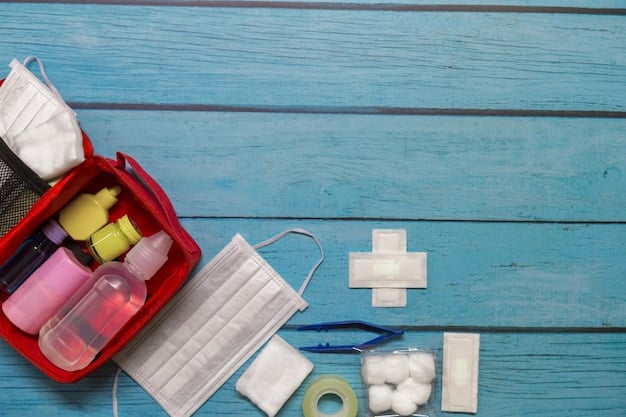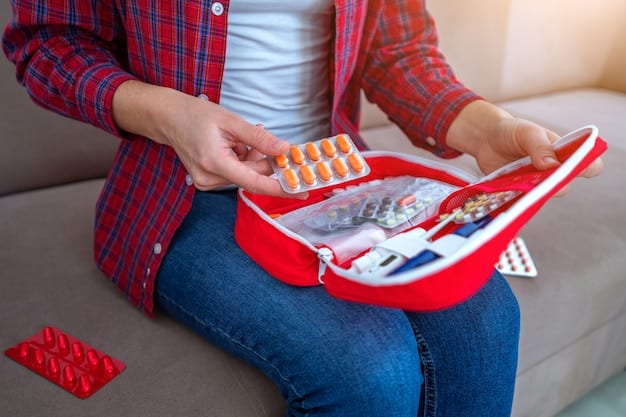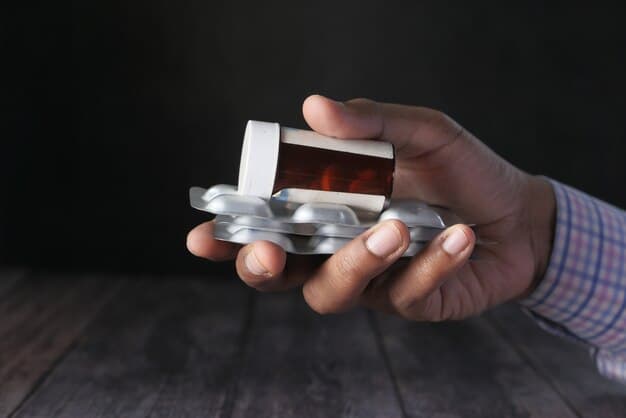First Aid Essentials: Build Your Home & Car Emergency Kit

First aid essentials are crucial for effectively responding to unexpected health emergencies at home and on the road, which requires assembling a comprehensive emergency kit that addresses various potential injuries and medical needs.
Are you prepared for unexpected medical emergencies? A well-stocked first aid essentials kit is indispensable for both your home and car, ensuring you can respond effectively to injuries and sudden illnesses. Let’s explore how to build the ultimate emergency kit.
Understanding the Importance of First Aid Essentials
Having a well-stocked first aid kit is not merely a suggestion; it’s a necessity for every home and vehicle. Being prepared with the first aid essentials can mean the difference between a minor incident and a life-threatening situation. Are you truly ready to handle emergencies?
From minor cuts and burns to more serious injuries, accidents can happen anytime, anywhere. Being equipped with the right supplies and knowledge empowers you to provide immediate care, stabilize the situation, and potentially save lives.
Why a Pre-Assembled Kit Might Not Be Enough
While pre-assembled kits offer a starting point, they often fall short of meeting individual needs. These kits might lack specific items necessary for your family’s health conditions or the types of activities you frequently engage in. Customizing your kit ensures that you’re truly prepared for any eventuality.
- Pre-assembled kits often contain generic, low-quality items.
- They may not include enough of certain supplies for multiple uses.
- Specific medications or tools for chronic conditions are typically absent.
- Customization allows you to tailor the kit to your family’s unique needs and risks.
Therefore, taking the time to create a comprehensive and personalized kit is a worthwhile investment in your safety and well-being.
In conclusion, understanding the importance of first aid essentials and customizing your kit can provide you with the confidence to handle unexpected medical situations effectively. Ensuring your kit contains items specifically relevant to your environment and your family’s health needs can save time and potentially lives during an emergency.

Key Components of a Home First Aid Kit
A comprehensive home first aid kit should address a wide range of potential injuries and illnesses. Equipping your kit with the right first aid essentials ensures you’re prepared for anything from minor scrapes to more serious medical events. What should your kit include?
Essential items include bandages of various sizes, antiseptic wipes, gauze pads, adhesive tape, pain relievers, and any personal medications. A thermometer, scissors, tweezers, and a CPR mask are also important additions.
Must-Have Medications and Supplies
Beyond the basics, consider including specific medications and supplies tailored to your family’s needs. This might include allergy medications, anti-diarrheal medicine, cold and flu remedies, and any prescription medications that family members regularly use.
Additionally, having items like instant cold packs, burn cream, and eye wash can be invaluable for treating specific injuries. Don’t forget a first aid manual or guide to help you administer care correctly.
- Pain relievers (ibuprofen, acetaminophen)
- Antihistamines for allergic reactions
- Antiseptic wipes and ointment
- Gauze pads and bandages of various sizes
Ensuring these essentials are readily available can make a significant difference in managing common ailments and injuries.
In conclusion, a well-stocked home first aid kit should include both basic and specialized items to address a wide range of potential medical issues. Regularly checking and replenishing your supplies will ensure that you’re always prepared to provide effective first aid care.
Building a Car Emergency Kit: Mobility and Preparedness
A car emergency kit is just as crucial as a home kit, especially considering the amount of time many people spend on the road. Being equipped with first aid essentials in your vehicle can help you respond to accidents or medical emergencies while traveling. But what should you include in your car kit?
A car kit should include similar items to a home kit but with a focus on portability and durability. Compact bandages, antiseptic towelettes, pain relievers, and gauze are essential. Additionally, consider including items specifically for car-related emergencies, such as a seatbelt cutter, reflective triangles, and a flashlight.
Adding Vehicle-Specific Emergency Items
While medical supplies are crucial, a car emergency kit should also contain items that can help you deal with vehicle-related issues. Jumper cables, a tire repair kit, a multi-tool, and a blanket can be invaluable in unexpected situations.
Ensure that all items are stored in a durable, waterproof container that can withstand the rigors of travel. Keeping your kit easily accessible in the trunk or backseat ensures that you can quickly retrieve it when needed.
- Jumper cables for a dead battery
- Reflective triangles to warn other drivers
- A flashlight with extra batteries
- A blanket for warmth in cold weather
These additions can significantly enhance your ability to handle roadside emergencies safely and effectively.
In summary, a car emergency kit should contain both medical supplies and vehicle-specific items to address a range of potential issues on the road. Regularly inspecting and replenishing your kit ensures that you’re always prepared for the unexpected.
Maintaining and Regularly Updating Your Kits
Having a well-stocked first aid kit is only half the battle. To ensure that your kits remain effective, proper maintenance and regular updates are essential. This means periodically checking your first aid essentials to ensure that they’re not expired or damaged. How often should you check your kits?
Experts recommend checking your kits at least every three to six months. During these checks, pay close attention to expiration dates on medications and other perishable items. Replace any items that have expired or are nearing their expiration date.
Best Practices for Inventory Management
Implement a system for tracking the items in your kits and their expiration dates. This can be as simple as a checklist or a more sophisticated inventory management system. By staying organized, you can quickly identify what needs to be replaced and ensure that your kits are always fully stocked.
Additionally, store your kits in a cool, dry place away from direct sunlight. Extreme temperatures and humidity can degrade the quality of medications and other supplies, reducing their effectiveness. Proper storage is key to maintaining the integrity of your first aid essentials.
- Check expiration dates every 3-6 months
- Replace expired or damaged items immediately
- Store kits in a cool, dry place
- Use a checklist for inventory management
These practices will help you maintain your kits in optimal condition.
In conclusion, maintaining and regularly updating your first aid kits is crucial for ensuring that they remain effective in times of need. By implementing a consistent system for checking and replenishing your supplies, you can have confidence that you’re always prepared to provide proper first aid care.

Advanced First Aid Knowledge: CPR and Beyond
While having a well-stocked first aid kit is essential, possessing advanced first aid knowledge can significantly enhance your ability to respond to emergencies. Learning CPR and other advanced techniques can empower you to provide critical care in life-threatening situations. How can you expand your first aid skills?
Consider taking a CPR and first aid certification course through a reputable organization like the American Red Cross or the American Heart Association. These courses provide hands-on training in essential life-saving skills, including CPR, choking relief, and basic first aid for various injuries and illnesses.
Enrolling in First Aid and CPR Training
Investing in first aid and CPR training is an investment in your ability to save lives. These courses not only teach you the necessary skills but also provide you with the confidence to act quickly and effectively in emergency situations.
Regular refresher courses are also important to keep your skills sharp and up-to-date with the latest guidelines. Maintaining your certification ensures that you’re always prepared to provide the best possible care.
- Enroll in a certified CPR and first aid course
- Learn how to perform CPR on adults, children, and infants
- Understand how to assist someone who is choking
- Know how to treat common injuries and illnesses
These skills can be invaluable in a variety of emergency scenarios.
In summary, expanding your first aid knowledge through CPR and other advanced training can significantly increase your ability to respond effectively to emergencies. Keeping your skills current through regular refresher courses ensures that you’re always prepared to provide life-saving care.
Customizing Your Kit for Specific Needs and Environments
Every household and environment has unique needs, and your first aid kit should reflect those specific requirements. Customizing your kit ensures that you’re prepared for the most likely scenarios you might encounter. How can you tailor your first aid essentials to meet your needs?
Consider factors such as your location, the age and health conditions of your family members, and the types of activities you frequently engage in. For example, if you live in an area prone to natural disasters, your kit should include extra water, non-perishable food, and a weather radio.
Addressing Specific Health Conditions
For families with members who have chronic health conditions like diabetes, asthma, or allergies, it’s crucial to include specific medications and supplies to manage these conditions. This might include extra insulin, inhalers, epinephrine auto-injectors (EpiPens), and blood glucose monitoring supplies.
Ensuring that these items are readily available and that family members know how to use them can be life-saving in an emergency. Additionally, keep a list of emergency contacts and medical information in your kit, including any allergies or medical conditions.
- Include extra medication for chronic conditions
- Add supplies specific to your environment
- Keep a list of emergency contacts and medical information
- Tailor the kit to your family’s activities and risks
These customized additions can provide peace of mind and ensure you’re ready for any situation.
In conclusion, customizing your first aid kit to meet specific needs and environments is essential for ensuring that you’re prepared for the most likely emergencies you might encounter. By considering factors such as location, health conditions, and activities, you can create a kit that is tailored to your unique requirements.
| Key Point | Brief Description |
|---|---|
| 🩹 Essential Supplies | Bandages, antiseptic wipes, gauze, tape, pain relievers. |
| 💊 Medications | Allergy meds, anti-diarrheal, personal prescriptions. |
| 🚗 Car Kit Additions | Jumper cables, reflective triangles, blanket. |
| 🗓️ Regular Checks | Inspect kits every 3-6 months, replace expired items. |
Frequently Asked Questions (FAQ)
▼
A basic kit should include bandages, antiseptic wipes, gauze pads, adhesive tape, pain relievers, and a first aid manual. These items cover minor injuries like cuts and scrapes.
▼
It’s recommended to check your kit every 3-6 months. Review the contents, replace expired medications, and restock any used items to ensure readiness.
▼
Besides standard first aid items, include jumper cables, reflective triangles, a flashlight, and a blanket. These items address vehicle-related emergencies effectively.
▼
Store your kit in a cool, dry place, easily accessible to all family members. Avoid direct sunlight and extreme temperatures to preserve the integrity of the supplies.
▼
Customization ensures your kit addresses specific needs, such as chronic conditions or environmental factors. It prepares you for unique emergencies relevant to your situation.
Conclusion
Building a comprehensive first aid kit for your home and car is a crucial step in preparing for unexpected emergencies. By understanding the key components, maintaining your kits regularly, and customizing them to your specific needs, you can confidently respond to injuries and illnesses, ensuring the safety and well-being of yourself and your loved ones.





